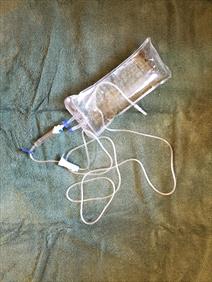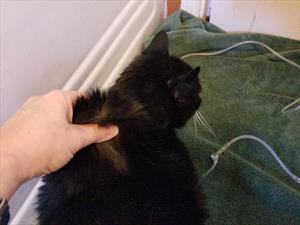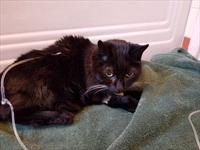Giving Subcutaneous Fluids at Home
There are numerous circumstances under which a patient may require fluid administration under the skin in the home setting. Any time extra fluids are needed to ensure hydration, fluids are generally easy for you to give and comfortable for your pet to receive. A patient might need fluids temporarily, perhaps during recovery from an illness, or ongoing as for an indefinite problem such as renal insufficiency. In either case, if you are reading this, subcutaneous fluids have probably been recommended for your pet, and you have already seen a demonstration on giving fluids.
Needles
Needles are color-coded according to the bore size of the needle. The higher the number, the smaller the needle bore. Most fluids are administered with 20 gauge (usually pink), 18 gauge (usually olive color), or 19 gauge (usually Kelly green) needles. The smaller bore needles are less painful to your pet; however, the fluid flow will be slower. The larger bore needles produce a faster fluid administration but are sometimes more objectionable to the patient. Occasionally a patient is sensitive enough to require a 22-gauge (blue) needle or even a 25-gauge (red) needle. As you refill your needle prescription, you may wish to experiment with different sizes to see what seems to work best for you and your pet.
Needles come either with a twist-off plastic seal or in a paper and plastic envelope which can be peeled back. Needles are sealed in one of these ways to maintain sterility. The needle hub, which is clear plastic or metal, slips or twists onto the end of the drip set. After giving the fluid, the needle should be removed for disposal, and a fresh capped needle should be attached to prevent exposing the line to bacteria. Needles should be used only once and then discarded appropriately (see below).
Your veterinary clinic might have an appropriate disposal company contracted to remove medical waste; if so, ask the clinic if you can return the syringes there.
You can probably also bring them to your local pharmacy, as many pharmacies perform this service. Check to see if your local pharmacy will take care of this.
Drip Sets
The drip set is the long plastic tubing that connects the fluid bag to the needle. Drip sets come in different sizes according to drop size. For efficient fluid administration, you want a size no smaller than 20 drops per cc. The larger the drop size, the faster the fluid administration will go. (The more drops per cc delivered by the drip set, the smaller the drop size; for example, a micro drip delivers 60 drops per cc. The larger the number on the drip set, the smaller the drops. You want a smaller number on the drip set for a larger drop size. We recommend 10 or 15 drops per cc.)
There will be a small clamp of some kind on the fluid line that will enable you to open and close the line. For subcutaneous fluid administration, the line will either be closed (when not in use) or all the way open (when fluids are given). Sometimes the tubing kinks slightly when it has been pinched closed for a while. You may use your fingers to re-open the line and move the clamp to a different area on the tubing so as not to keep pinching (and thus deforming) the same area of tubing. To avoid making a mess, you may want to close the clamp before hooking up the line to the bag or just be quick to close the clamp afterward.
The drip set will have a small chamber towards the top where you can see how fast the fluids are running. You will want the fluids to run as fast as possible so as to finish the task quickly. If the chamber completely fills with fluid, you will not be able to see the drip flow. To remedy this problem, invert the set, squeeze the chamber slightly so as to allow some air into the chamber, turn the set right side up and open the flow so as to expel air from the fluid line.
Assembled drip set

Assembled drip set. Photo by MarVistaVet
If the drip set is not connected to the bag of fluids when you purchase your setup, the drip set can easily be connected. The fluid bag will have a seal of some kind which must be pulled off to open the bag. The sharp point on the end of the drip set is inserted here. Be sure to hold the fluid bag so that the open end is pointed up; otherwise, the fluid will drain out of the hole and make a big mess. In the photo on the right, the connecting port is vertical with a white plastic cap that can be pulled off and the pointed part of the drip set would be pushed in. Do not confuse this with the round rubber injection port that is on the front of the bag. Also, be aware drip sets come out of their bag or box in an open position so as soon as they are connected to the bag and the bag is inverted, fluid will run out the end until you close the drip set clamp.
You may discard your drip set with the empty fluid bag in the regular trash as long as the needle has been removed for separate disposal, as described below.
Fluid Bags
There are many types of fluids. They come in glass bottles as well as plastic bags. At our hospital, we mostly use one-liter plastic bags, which have demarcations printed on the side every 100 cc. Be sure you know how much fluid to administer and where on the bag the desired level at the end of administration will be. If you like, ask the technician to mark the bag with a pen.
Fluid bags may be given to you already connected to the drip set or they may be purchased separately. When purchased separately, they are often enclosed within another plastic bag to ensure sterility. A small amount of moisture between the two bags is normal and does not indicate a leak in the fluid bag.
See a video on how to assemble the equipment reviewed above and a recap of the above information.
How it's Done
We will begin assuming that the drip set, needle, and fluid bag are already connected, and the patient has been placed on the work surface (floor, table, counter, back of the sofa, etc.). The fluid set should be hanging from a location higher than the level of the patient.
Tenting

Tenting a cat's skin to get ready for giving subcutaneous fluids. Image Courtesy MarVistaVet
A second person can hold the fluids, or a wall-mounted towel or coat hanger can work. The bag can be set on its side at a level higher than the patient, but you will not be able to see the drip flow if the bag is not hanging vertically, and you will probably get lots of air in the line.
Pick up a handful of skin at the patient's scruff. This area has a sparse population of nerve endings, and the needle is likely to hurt the least in this area. The farther toward the tail you go with the needle, the more the patient will feel the stick. Note that a "triangle" is formed in the skin.
Fluid administration

Fluid administration. Image Courtesy MarVistaVet
Uncap the needle and boldly stick it through the skin right in the center of the triangle. You should feel a slight punch as the thick skin is penetrated. You may relax your grip a bit, depending on your confidence that your pet will continue to sit still.
Open the drip set clamp and let the desired amount of fluid run in. A small bulge will appear under the patient's skin as fluid accumulates there.
- If the needle has gone through the skin and out the other side, a stream of fluid will be seen coming from the patient's skin. If this occurs, simply pull the needle slightly back toward you but not all the way out so that the needle will again be positioned under the skin. If this is too hard, simply close the drip set clamp and start over.
- If the drip rate in the chamber seems slow, change the angle of the needle insertion slightly with your fingers until you get a better drip-rate.
When the proper amount of fluid has been delivered, close the clamp, withdraw the needle, and recap it or dispose of it and replace it with a fresh capped needle. If a relatively large amount of fluid is to be delivered, you may have been instructed to administer fluids in two locations. If so, repeat the procedure for the second area.
- After fluid administration, the bulge of fluids will tend to droop down around the front legs or chest. This is normal, but if this bulge has not resolved by the time you are supposed to give fluids next, do not give the next fluid dose. This would mean that your pet's circulation is not good enough to absorb the fluids or that your pet simply does not need the extra fluids. In either case, report this to your veterinarian, and your instructions will probably be revised.
If you are unable to accomplish this procedure at home, your veterinarian should allow you to bring your fluid set up and pet to their hospital for the administration of fluids by their staff.
Other Methods for Home Hydration
To assist people who find needle sticks objectionable for their pets, there are a couple of products that may be able to make subcutaneous fluid administration possible. The first is the GIF Tube made by Practivet. The product is a soft tube that is implanted under the pet’s skin in a minor anesthetic procedure. An injection port protrudes from behind the pet’s neck, and the fluid port can be inserted here without the pet feeling it. The disadvantage is that the pet will have a plastic disc on the base of his neck (an area where petting is traditional and thus somewhat disrupted). Also, general anesthesia (though brief) is required for implantation.

Bear has an esophagostomy feeding tube. Image Courtesy MarVistaVet.
An alternative form of fluid administration is the esophagostomy tube. A tube is placed through a small hole in the esophagus (the tube connecting the mouth and stomach). Fluids can be given through this tube and into the stomach, thus avoiding the needle stick. The tube can stay comfortably in place for months but the hole will require regular cleaning and bandaging at home. A cat with an Esophagostomy tube should not be allowed outside in case the tube or wraps become entangled in bushes, fences, etc. General anesthesia is required to place this tube. For more details on Esophagostomy tubes, click here.
If you might be interested in something like these, talk to your veterinarian for details.
Disposal of Used Needles
Needle Removal
The first step in disposing of used needles is removing the needle from the drip set. This may sound simple, as the needle twists off easily but it is important to review the technique as it is possible to stick yourself badly if you are not careful. The needle should be removed from the drip set and discarded uncapped. This may seem counterintuitive, but it turns out that most needle injuries occur trying to recap needles. Twist off the needle from the drip set and deposit it in a puncture-proof plastic or metal container as soon as you are finished with fluid administration. Keep this container covered so as to avoid spills.
Do not leave the end of the drip set uncovered. As soon as the old needle is removed, replace it with a fresh capped needle so as not to leave the line open to environmental contamination.
Needle Disposal
In the past, disposal of used needles and syringes was simple: You could simply place used syringes, lancets, and other sharps in a thick plastic container (such as the type liquid laundry detergent comes in) and when it was full, discard the entire container in the regular trash. This may still be fine in some areas, but not all so ask your veterinarian about local laws. Never throw away a needle without a container as the needle can injure the people handling and processing refuse.